Key takeaways:
- Mixed media art fosters creativity by blending various materials, allowing artists to express emotions in unique ways.
- Art galleries provide crucial platforms for artists, facilitating visibility, dialogue, and educational opportunities, which can transform an artist’s self-perception.
- Experiencing nature and contemporary artists shapes one’s artistic vision, encouraging experimentation and the use of organic materials in mixed media.
- Exhibiting artwork in galleries can be nerve-wracking yet rewarding, as it opens up opportunities for engagement, feedback, and personal growth.
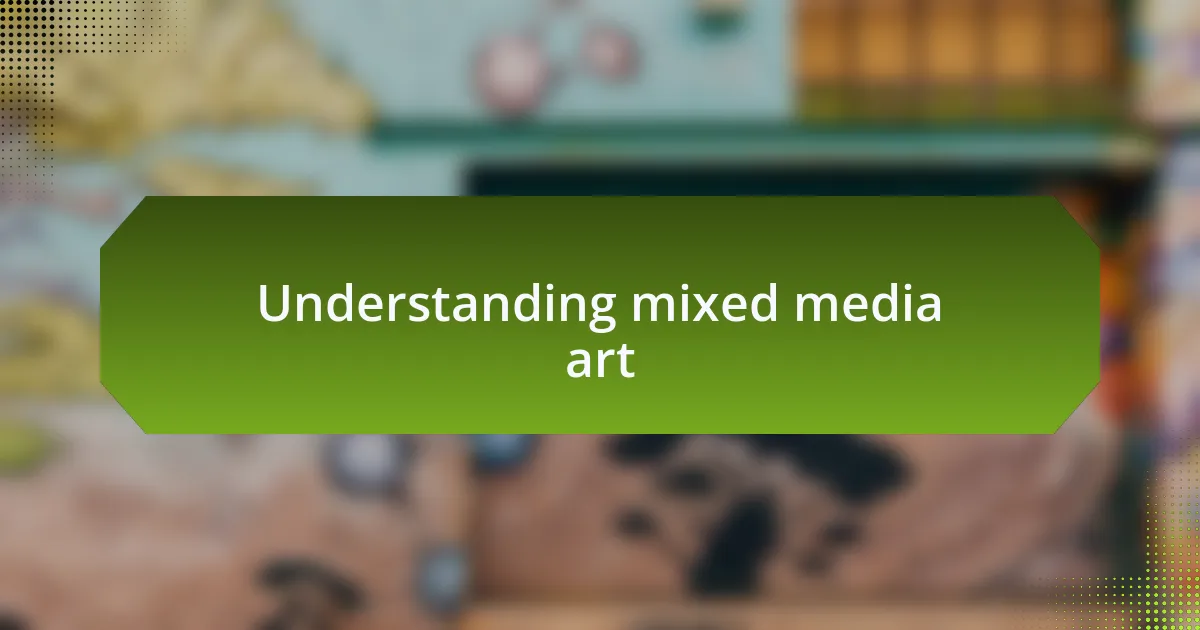
Understanding mixed media art
Mixed media art is truly a playground for creativity. It’s fascinating how artists blend various materials—like paint, collage, textiles, and found objects—to create a piece that speaks on multiple levels. I remember the first time I glued bits of fabric onto my canvas; the tactile experience was so liberating! It allowed me to express emotions that I often couldn’t articulate with paint alone.
What I love about mixed media is that it challenges traditional boundaries of art. Have you ever considered how the textures and layers can evoke different feelings? I often find myself exploring how a rough piece of burlap can contrast a smooth layer of acrylic paint, stirring a dialogue within the artwork that invites viewers to look closer. It’s like creating a conversation on the canvas, where every texture tells a story.
The beauty of mixed media lies in its non-conformity. I’ve found that there are no strict rules; every artist can develop their unique voice through diverse techniques. This freedom has opened my eyes. As I add elements like paper clippings or even photographs, I feel like I’m telling a multifaceted story. Isn’t it intriguing to think about how viewers interpret these layers differently? Each piece becomes a reflection of the artist’s journey, making it an intimate experience for both the creator and the audience.
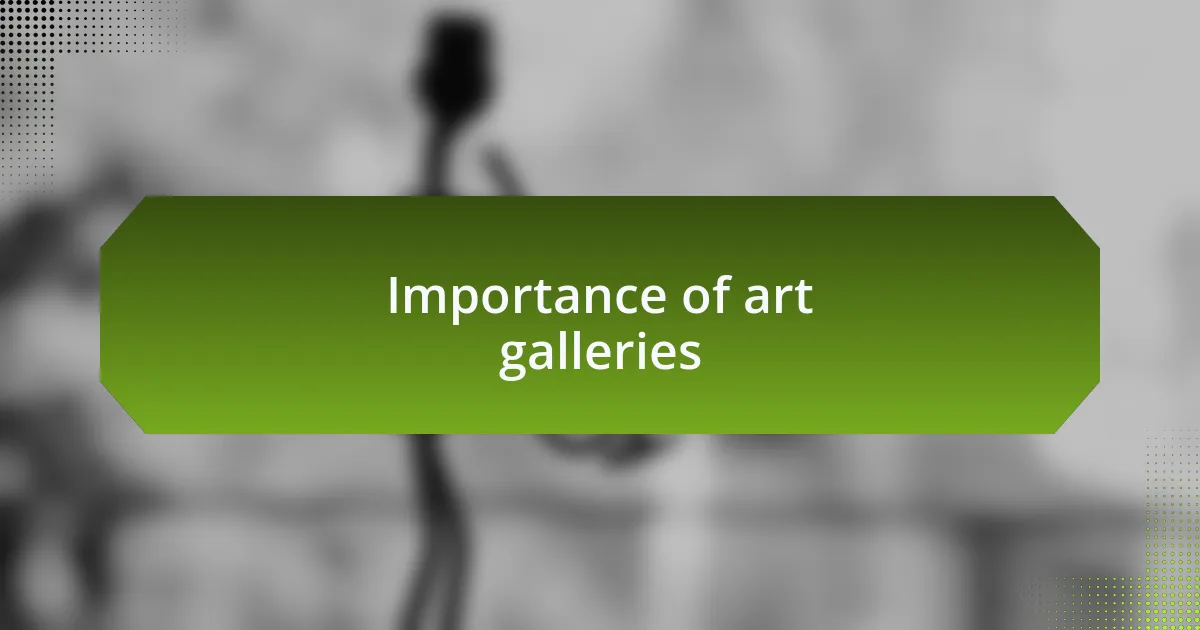
Importance of art galleries
Art galleries play a vital role in connecting artists with the public, fostering a dialogue around creativity. I recall my own visit to a local gallery, where I felt a rush of inspiration just by being surrounded by diverse artworks. It’s enlightening to see how different pieces resonate with various viewers, creating a shared experience that sparks conversations about artistic intentions and interpretations.
Moreover, galleries provide a platform for emerging artists to showcase their work, offering them visibility in a competitive field. Think about how intimidating it must feel for new creatives to share their art with the world. I’ve witnessed firsthand how having a piece exhibited can validate an artist’s hard work and motivate them to continue developing their craft, transforming self-doubt into confidence.
The educational aspect of galleries cannot be overlooked; they often host workshops, talks, and exhibitions that deepen our understanding of art. During one such workshop, I learned about the historical context behind mixed media techniques, which added layers of meaning to pieces I once overlooked. Isn’t it fascinating how knowing the story behind an artwork can change your entire perception of it?
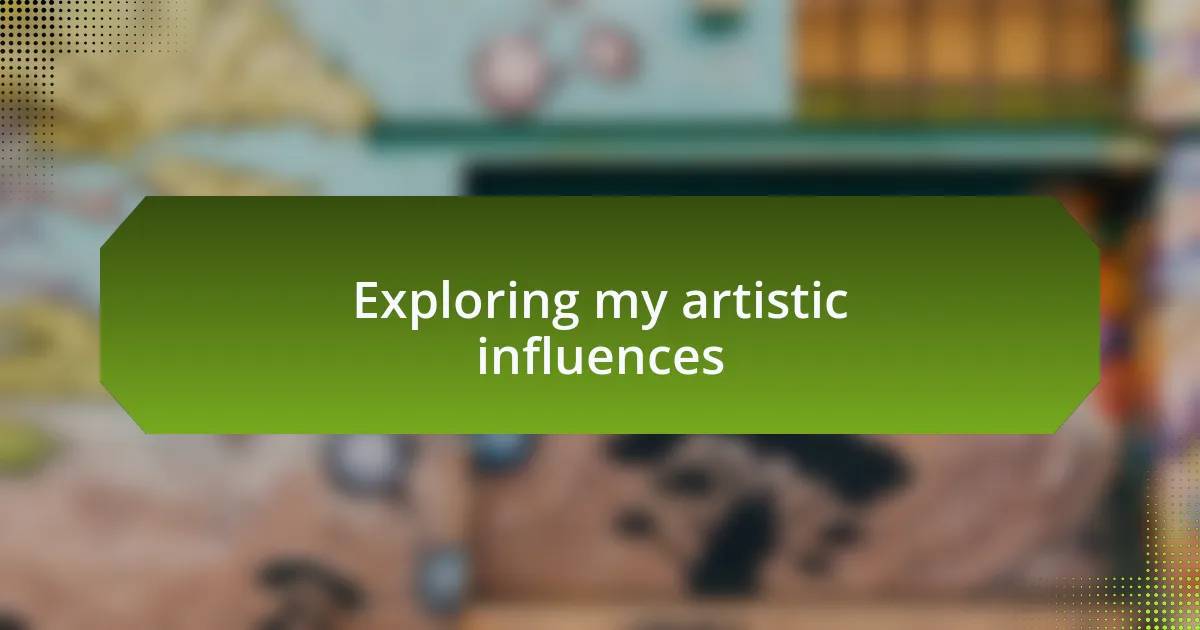
Exploring my artistic influences
Artistic influences can often be traced back to the moments and the people who inspire us the most. For me, it was an art teacher in high school who introduced me to the concept of mixing different mediums. I remember the day she encouraged me to experiment with paint, collage, and photography all on one canvas. The thrill of blending these elements ignited a passion I didn’t know existed within me.
I also find that nature plays a profound role in shaping my artistic vision. During a solitary hike, I stumbled upon a mosaic of colors: vibrant leaves, textured rocks, and flowing water. This experience made me realize how the natural world serves as a vast palette, urging me to incorporate organic materials into my work. Have you ever paused to appreciate how nature’s imperfections can lead to stunning artistry?
Beyond personal encounters, I draw inspiration from contemporary mixed-media artists whose work speaks to me. I often revisit the pieces of artists who incorporate storytelling into their art, realizing how much narrative can elevate visual expression. Their ability to evoke emotion through texture and layering prompts me to push my boundaries and explore my own storytelling potential. How can I not be inspired by those who masterfully weave tales into their creations?
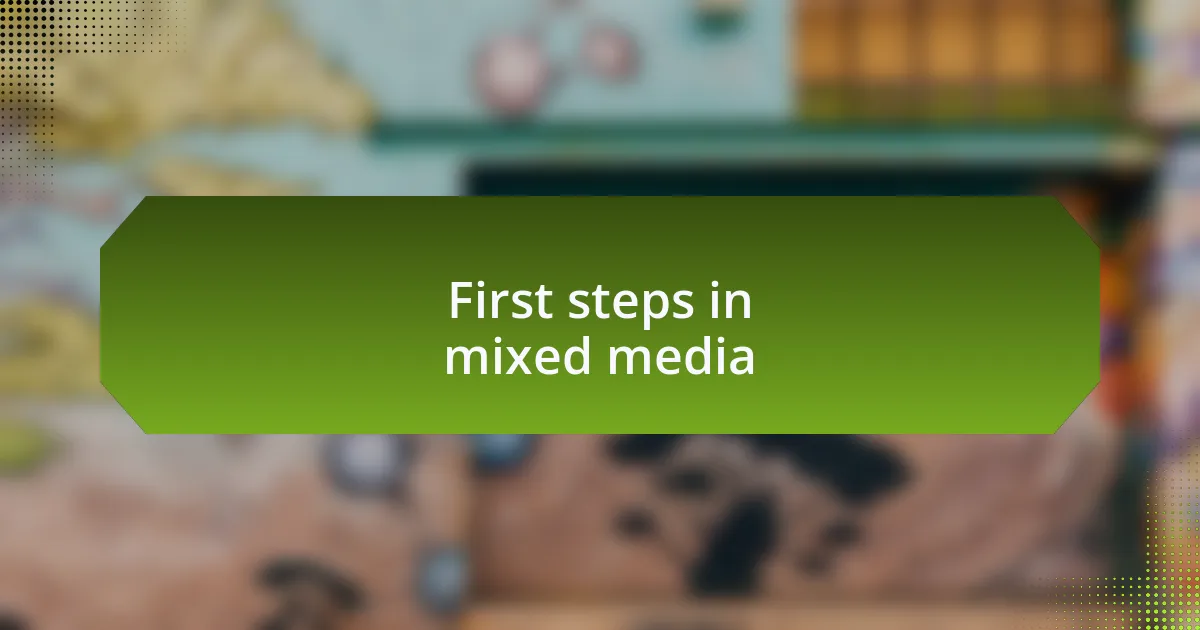
First steps in mixed media
The first steps in mixed media can be both exciting and intimidating. I remember my initial experiences with layering materials; it felt like a dance of textures and colors, where each addition spoke to me. At one point, I decided to incorporate fabric scraps into my artwork, which added depth and a tactile quality that paint alone couldn’t achieve. Have you ever wondered how a simple piece of fabric could transform your artistic expression?
As I embarked on this creative journey, I found that experimentation was vital. Early on, I started grabbing anything that caught my eye—old postcards, magazine cutouts, and even dried flowers. The joy of discovery was palpable as I realized that these seemingly random items could evoke powerful emotions and memories when arranged together. How could these bits and pieces from my life not tell a story?
Looking back, I see that my willingness to play and take risks paved the way for my growth as a mixed media artist. I vividly recall creating a piece where I intentionally bundled layers of paper and stickers, only to peel parts away later, unveiling hidden parts of the composition. This process taught me the beauty of imperfection and the importance of letting go. Isn’t there something liberating about embracing spontaneity in art?
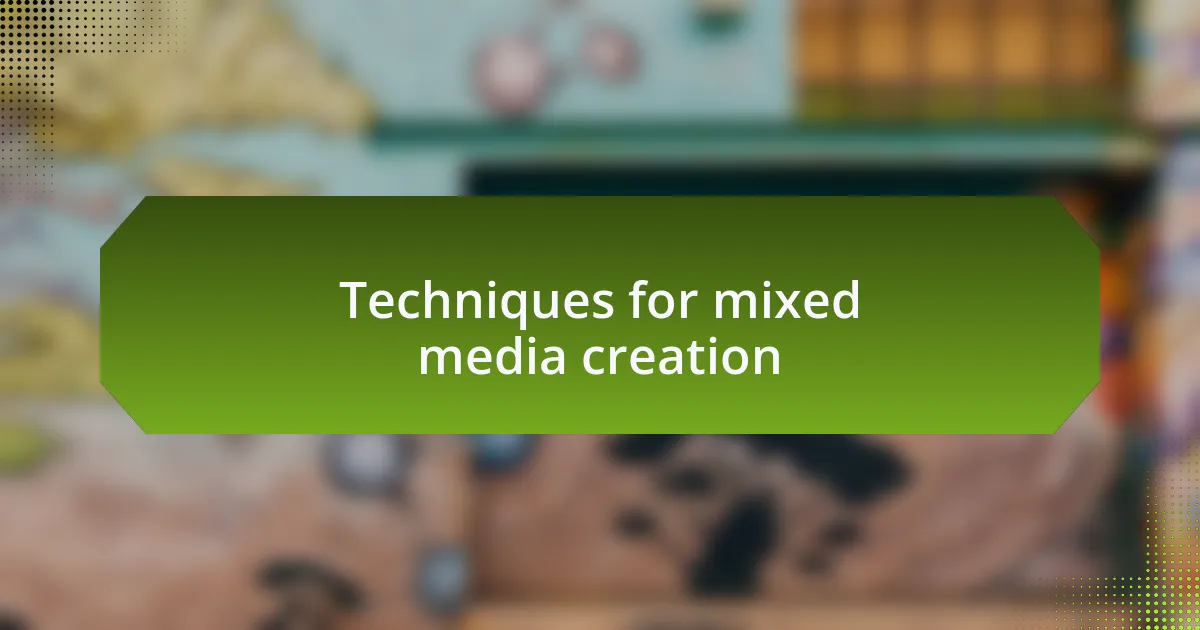
Techniques for mixed media creation
Mixed media creation opens up a world of possibilities, and one technique I’ve found particularly compelling is collage. When I first started experimenting with this method, I would spend hours sifting through old magazines and my collection of photographs, curating images that resonated with me. I quickly learned that juxtaposing different visual elements could evoke a complex narrative, almost like piecing together a puzzle where every fragment held significance. Have you ever felt that spark when you find just the right image to complete your vision?
Another technique I embraced is the incorporation of mixed materials to enhance texture. In one of my pieces, I experimented by mixing acrylic paint with sand to create a gritty surface. As I applied it to my canvas, the sensation was exciting—each brushstroke felt different, and the colors took on new dimensions. This tactile experience not only transformed the visual outcome but also deepened my connection to the art itself. Can you imagine how diverse a piece can become with just a slight change in material?
Finally, I discovered the power of layering. Techniques like glazing, where you apply thin transparent layers of paint, allowed me to build depth in my work. I remember vividly the moment I layered a bright yellow wash over a darker underlying color; the result was captivating. It was as if the hidden layers whispered their stories, creating an enchanting depth that drew viewers in. Have you noticed how layering can create a sense of mystery in art?
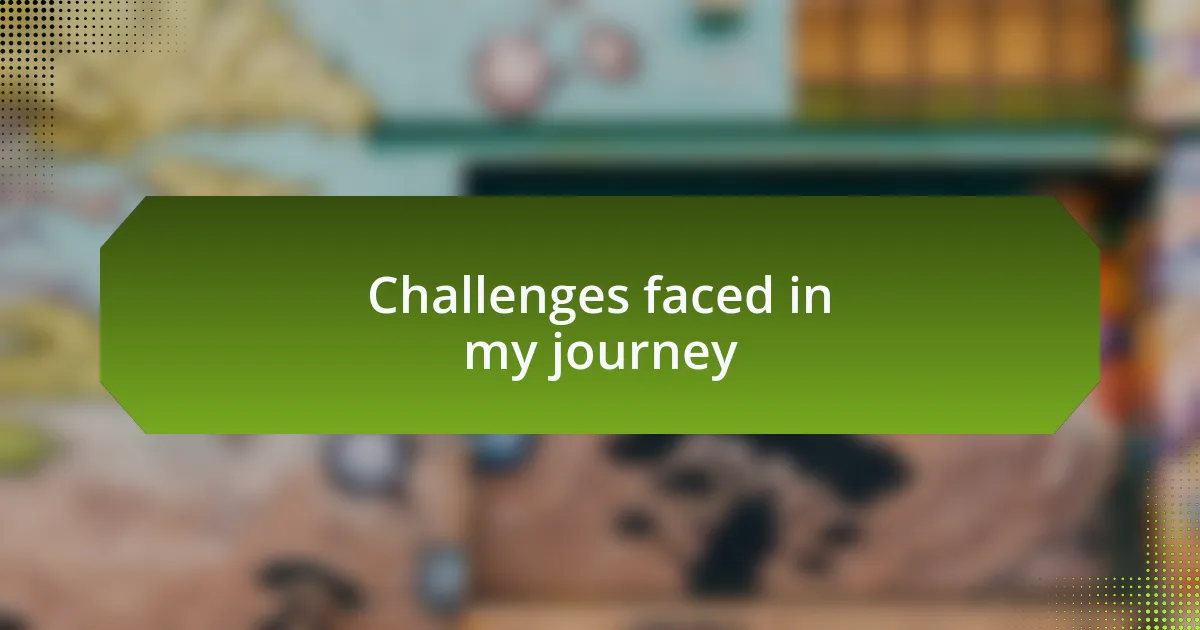
Challenges faced in my journey
The journey into mixed media art has been anything but smooth. Initially, I faced a struggle with self-doubt. There were days when I’d stare at my canvas and feel overwhelmed, questioning if my ideas were valid or if I was merely playing with materials. It took time for me to realize that vulnerability can be a source of strength. Have you ever found yourself doubting your creative instincts?
Another significant challenge was the constant battle with perfectionism. I remember an occasion when I spent hours meticulously arranging components only to step back and realize it didn’t feel right. In those moments, I learned that letting go of control often leads to the most surprising and beautiful outcomes. Can you think of a time when an unexpected turn in your work led to something greater?
Moreover, navigating the varying reactions to my art was a hurdle I hadn’t anticipated. Early on, I shared a piece that I felt truly represented me, only to receive mixed feedback. It stung, but I soon grasped that art is subjective and each reaction provided an opportunity for growth. Have you ever felt the sting of criticism turn into encouragement? Embracing this perspective has made me stronger and more open to exploration in my artistic endeavors.

Exhibiting my work in galleries
Exhibiting my work in galleries was a significant milestone for me. I vividly remember the first time I walked into a space where my art was displayed—it felt surreal and nerve-wracking all at once. Standing beside my pieces, I could feel my heart racing as I watched people engage with my work. How does it feel to see someone connecting with something you’ve poured your soul into?
One of the most enlightening experiences came when I participated in a local group show. I was initially apprehensive about how my mixed media approach would be received among more traditional artists. To my surprise, several visitors gravitated towards my pieces and shared their interpretations. This interaction reminded me that art has the power to spark conversations, transcending the boundaries of technique and style. Have you ever had a moment where the reaction from someone moved you deeply?
The feedback I received from art patrons was incredibly valuable. Some expressed admiration for my unique blend of materials, while others offered constructive criticism. I remember one insightful comment that encouraged me to explore color more boldly. Their perspectives not only nourished my growth but transformed my view of exhibiting—turning it from a daunting task into a collaborative dialogue. Have you ever found that feedback can reshape your creative vision?